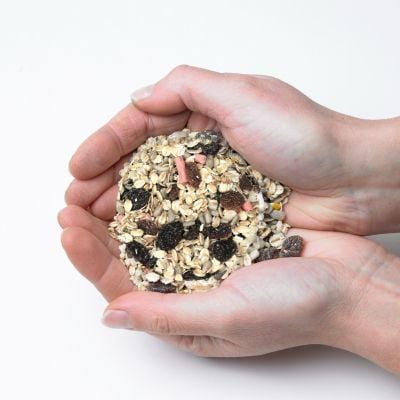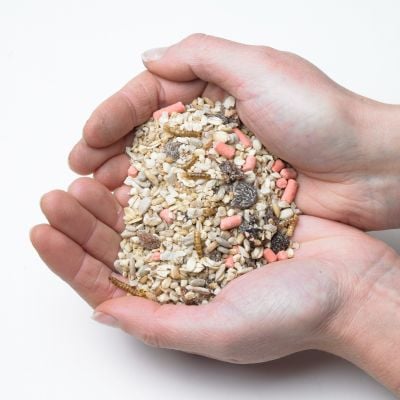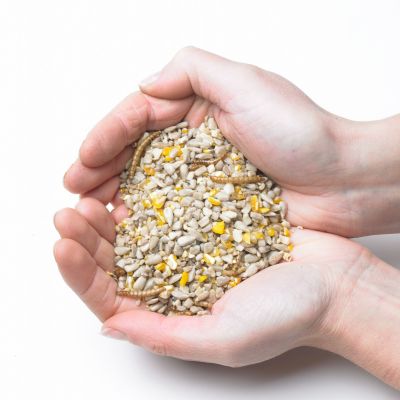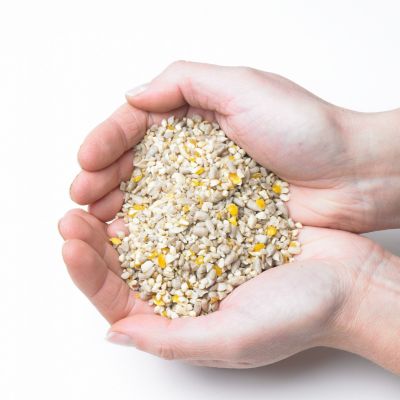Wood Pigeon Factfile
The Wood Pigeon has become an abundant wild bird species in the UK, having expanded its very historic range from woodland to also include more open country, parks and gardens – even in very urban areas. In areas of arable farmland and especially where brassicas are grown such as cabbage and oilseed rape, Wood pigeons can be a serious agricultural pest, and also can be in gardens and allotments for much the same reason. However, with this unfortunate fact put to one side, the Wood pigeon is a handsome bird and can actually be a useful addition at garden feeding stations, as one or two birds will often stand below hanging feeders and clear up all the dropped seed. The only species that the Wood Pigeon can be confused with are the Stock dove, Rock dove and Feral pigeon, but note the distinct white collar on the Wood Pigeon only.
The scientific name for the Wood Pigeon bird species is Columba palumbus, and they are part of the bird family called columbidae – the Collared dove, another common garden bird, is also in this family. A non-scientific name given to pigeons and doves in the UK is culver.
The common Woodpigeon is a fairly chunky garden bird, and is also a strong and fast flyer with a wingspan of between 68 to 80cm. Female Wood Pigeons are very similar in their plumage to males, though the white neck patch is smaller and the breast not as strong in colour. Juvenile Wood Pigeons are duller in colour overall, and also don’t have the distinct white on the sides of the neck. In flight, the white wing patches of Wood Pigeons are very obvious.
The average lifespan of a Wood Pigeon (taking out the factor of them being shot for sport or on farms as a pest) is three years, though the record for an individual bird is apparently a very impressive 17 years and 9 months.
Video footage of Wood Pigeons
Wood Pigeon nesting and breeding habits
Although the nest of twigs appears rather inadequate for the bird’s size and weight – sometimes the eggs are visible through the nest from below – it is none the less usually a firm enough structure. The nest is built in a tree or large bush, and sometimes old nests of other species are used. In gardens, large conifers such as Leylandii are often favoured.
There are 2-3 broods per year with just two white eggs in each clutch, which both parents take turns to incubate, with Incubation lasting for around 18 days. Interestingly and of note, the young are fed with a highly rich milk (which is even richer than cow’s milk) which is produced in the adult bird’s crop lining and is referred to as pigeon milk. Fledgling pigeons are often referred to as squabs.
The breeding season for Wood Pigeons is exceptionally long, and although the main season is between April and October, the species has been recorded breeding in every month of the year. This ability to breed year-round and outside of the normal season for garden birds and other wild birds, is largely because of the species’ ability to survive on plant material alone, with winter sowings of oilseed rape being a key food source in areas of the country where arable farming is prevalent.
Young Wood Pigeons fledge at around 33 days, though because of the vulnerability of their nests to predators, some young birds survive outside the nest in the cover of branches after just 20 days and despite being unable to fly.
Wood Pigeon history and population trends
The Wood Pigeon has greatly increased in numbers and especially since the mid-1970s. It’s believed that part of the reason for this increase is down to the spread of winter cereal and rape seed cultivation (oil rapeseed is a type of brassica), and therefore with a greater availability of winter food, more birds survive to breed in the spring. This winter food supply and the fact that the species can feed exclusively on plant material such as brassicas, has also meant that some birds will even breed in the winter months.
There has also been a greater tendency for Wood Pigeons to live and breed in urban areas, with the two main factors helping this being the availability of bird food put out in gardens, plus suitable nesting sites in conifer trees and notably Leylandii.
Behaviour traits of Wood Pigeons
During the breeding season Wood Pigeons are largely a solitary species, but for the rest of the year are much more gregarious and can form huge flocks where food is present – e.g. on winter fields of young rapeseed.
During the breeding season, male Wood Pigeons will often pursue female birds on the ground in a strutting manner and display a puffed-up neck, fan their tale and repeatedly bow their head. This behaviour is accompanied by a cooing sound. The cooing – which sounds like ‘coo-coo-coo’ – is also used by male birds to announce and help defend a breeding territory.
Male Wood Pigeons can be fiercely territorial in the main breeding season, which contrasts greatly with their gregarious nature when flocking to feed in the winter months – though some birds of this species will also breed in the winter months. That said, wood Pigeons will also often defend preferred roosting sites in the winter as well, with individual birds fighting for a particular space – which includes striking a rival bird with its wings and creating a clattering sound.
Wood Pigeons also like to use a bird bath, and often display a rather odd where there’ll try to submerge one side of their body into the water, with the wing on the other side outstretched.
Wood Pigeon diet and food
The diet is mainly vegetable matter and including crops such as cabbage and other brassicas – hence why the species is often considered a pest by farmers. They also eat grain, seeds, shoots, buds and berries – on the latter they will often feast on ivy berries in the autumn months. At garden feeding stations, any type of seed or seed mix will be eaten if it’s on the ground, a ground tray or bird table.
Of note, is the fact that the Wood Pigeon is the only species of bird in the British Isles which is able to survive on purely plant material – though in reality other foods such as seed, grain and berries will generally be eaten as well. The extent to which individual birds are dependent on plant material to survive will very much vary dependent on location and also season. For example, Wood Pigeons in rural areas which are intensively farmed will have a very high dependency on crops such a cabbage and oilseed rape in the winter months, whereas Wood Pigeons in urban areas may largely feed on bird seed put out in gardens at any time of year.
The Woodpigeon can eat and hold in its crop food of a surprisingly large size, which includes acorns in the late summer and early autumn.
What should I feed Wood Pigeons?
Wood Pigeons will eat any type of straight seed or seed mix put out, provided it’s on the ground, on a ground feeing tray or a bird table – the species cannot cling to a bird feeder. For some people putting out food to attract Wood Pigeons is not on their agenda and especially if thy also grow vegetables, though for others the species is welcome in their gardens as they do a great job of clearing up dropped seed below hanging feeders.
Bird Food
Frequently Asked Questions
Should you feed Wood pigeons?
This is a personal choice, though fair to say that there’s no ethical or scientific reason not to feed Wood pigeons in gardens. It’s also the case that if you put out food for other ground feeding species such as Blackbird, then Wood pigeons are anyway likely to turn up to feed as well. Plus, Wood pigeons do a great job on the ground underneath hanging tube feeders, as they eat all the seed which songbirds drop.
What is the life expectancy of a Wood pigeon?
Wood pigeons live for between three and five years, though there are records of some individual birds which have lived for up to 15 years.
Where do Wood pigeons sleep at night?
Wood pigeons normally sleep in trees and tall hedges, with Leylandii in gardens being a particular favourite.
Why do Wood pigeons sit out in the rain?
Like other species in the pigeon and dove family, Wood pigeons will sit out in the rain as a way to bathe – so like a human taking a shower. As part of the process, they will often hold one wing up at the time so the rain goes on the underside of the wing as well. And they’ll even do all this whilst sat in a bird bath!
Do Wood pigeons need water?
Yes, Wood pigeons need clean water to drink and bathe in.











